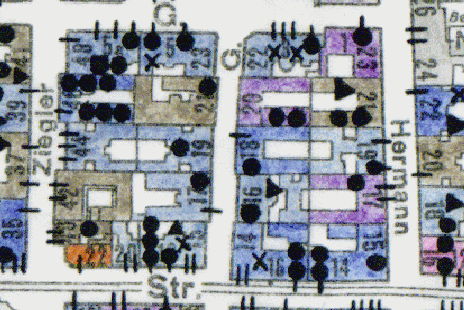
Background
Historical themed map sets contain extensive, often highly detailed information about urban structures, which however is not of much use for modern analysis, since they are not accessible in contemporary data banks. Having digital access to these map sets would enable users to make large-scale analyses of structural changes in urban areas on the level of buildings and apartment blocks. The long-term real-estate appreciation and depreciation within neighbourhoods can thus be analysed in detail. Examples of such historical map sets include:
- Hugo Hassinger’s 1912 ‘Kunsthistorischer Plan’, a map of the Vienna city centre, especially concerned with its objects of historical value from an artistic perspective
- Elisabeth Lichtenberger’s 1956 ‘Baualterkartierung Wien’, which documents the age of Viennese built structures
- The mapping of urban decay in Vienna, Bratislava, and Budapest, conducted by Elisabeth Lichtenberger et al. (1986)
These maps from the 1950s-1980s contain information on the age, usage, and condition of buildings at the level of individual built objects.

Project Design
The project is aimed at vectorising analogue urban research map sets that are not easily accessible otherwise. Using the Open-Data Portal, the information contained in the maps is to be made accessible for urban researchers for the first time in decades. It will thus be possible to process these maps using modern GIS techniques.
The maps are scanned, geo-referenced, and vectorised semi-automatically. The geodata resulting from these processes is catalogued and can be accessed, downloaded, and embedded into other web maps via a web portal, the functions of which are similar to that of numerous other open-government data portals.
The project expressly aims at multiplying cooperation, especially by advancing urban planning themes in scholarship (among national and international universities) and practice (urban planning, neighbourhood management), since there is potential of publishing further data sets.
Duration
01/03/2021 – 28/02/2022